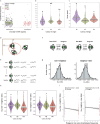Genetic variation influences food-sharing sociability in honey bees
- PMID: 40956789
- PMCID: PMC12440162
- DOI: 10.1371/journal.pbio.3003367
Genetic variation influences food-sharing sociability in honey bees
Abstract
Individual variation in sociability is a central feature of every society. This includes honey bees, with some individuals well connected and sociable, and others at the periphery of their colony's social network. However, the genetic and molecular bases of sociability are poorly understood. Trophallaxis-a behavior involving sharing liquid with nutritional and signaling properties-comprises a social interaction and a proxy for sociability in honey bee colonies: more sociable bees engage in more trophallaxis. Here, we identify genetic and molecular mechanisms of trophallaxis-based sociability by combining genome sequencing, brain transcriptomics, and automated behavioral tracking. A genome-wide association study (GWAS) identified 18 single nucleotide polymorphisms (SNPs) associated with variation in sociability. Several SNPs were localized to genes previously associated with sociability in other species, including in the context of human autism, suggesting shared molecular mechanisms of sociability. Variation in sociability also was linked to differential brain gene expression, particularly genes associated with neural signaling and development. Using comparative genomic and transcriptomic approaches, we also detected evidence for divergent mechanisms underpinning sociability across species, including those related to reward sensitivity and encounter probability. These results highlight both potential evolutionary conservation of the molecular roots of sociability and points of divergence.
Copyright: This is an open access article, free of all copyright, and may be freely reproduced, distributed, transmitted, modified, built upon, or otherwise used by anyone for any lawful purpose. The work is made available under the Creative Commons CC0 public domain dedication.
Conflict of interest statement
The authors have declared that no competing interests exist.
Figures




References
-
- Bonnell TR, Vilette C, Henzi SP, Barrett L. Network reaction norms: taking account of network position and plasticity in response to environmental change. Behav Ecol Sociobiol. 2023;77(3). doi: 10.1007/s00265-023-03300-2 - DOI
MeSH terms
LinkOut - more resources
Full Text Sources

